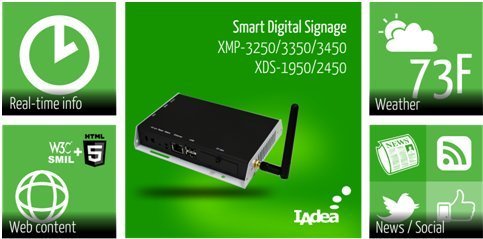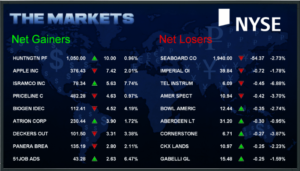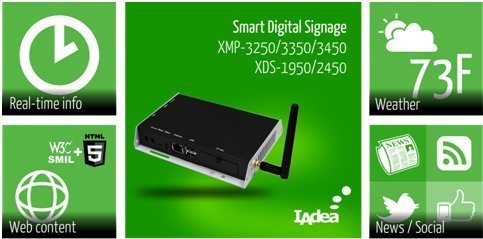
Updated: HTML5 Now Finding Its Way Into Digital Signage
January 9, 2012 by Dave Haynes
Taiwan-based computing device manufacturer IAdea has announced a set of media players that support the rapidly emerging HTML5 content standard – with the company suggesting broad industry adoption of HTML5 will lower content creation costs and power highly dynamic programming on low-cost boxes.
The company has announced three networked “XMP” playback devices it says are HTML5 ready, and a pair of integrated player-display combos called Web Signboards.
“In addition to displaying 1080p full-HD video, pictures, and sound,” says the press release, “the devices now all support dynamic rendering of data feeds using the latest HTML5, CSS, JavaScript technologies. The products are great for applications including: digital menu boards, transportation departure/arrival information, and hospitality signage at retail, banking, hotel, and corporate lobbies.”
HTML5 has been in development for many years, but it took the introduction of the iPad to get it more known outside geek circles. Apple said when the iPad launched that it was not going to support Adobe Flash on the tablet, saying the future of motion graphics and animations was in the web-based markup language and not with the buggy, resource-gobbling Flash web player.
The proposition is that HTML5 lets developers produce experiences that look and behave very much like Flash, but without requiring a browser plug-in – like the Flash player on my lappie that has already stalled out on me once today.
This is an interesting announcement, though not a big technology leap. I like how IAdea has packaged this up and shown dynamic graphics that look like they came out of the Windows Phone 7 UI team. I like how they have included some base Q&A stuff to explain HTML5 and how it could be applied, including use cases.
What IAdea has done is get a bit of a jump on the playback device competition by saying it is all over the next big thing. The company did that with SMIL going back a year and more, but SMIL hasn’t gone mainstream as hoped. HTML5 will.
There’s no particular gizmo or secret sauce to IAdea’s gadgets. Any current computing device is theoretically HTML5-compatible. Aopen, for example, could come out tomorrow saying its little players are HTML5-ready, whatever that might mean. The difference is that IAdea has built support for HTML5 right into the devices – using something called a webkit, which is basically the open source engine that gets browsers to open web pages.
Other devices would need to either do that as well, or rely on the browser to drive the HTML. So the question is less about the gadget as it is about the playback software driving it. Playback software that uses Chrome is in good shape because HTML5 is pretty much native in Google’s browser. But if the playback software is built around Microsoft’s Internet Explorer, it’s a different story – as HTML5 support is apparently pretty iffy still on IE.
 The larger story here is how a shift to HTML5 opens up a lot of possibilities. Stuff developed for the Web in HTML5 easily migrates over to screens, and the developer pool for content and interesting applications is therefore much bigger.
The larger story here is how a shift to HTML5 opens up a lot of possibilities. Stuff developed for the Web in HTML5 easily migrates over to screens, and the developer pool for content and interesting applications is therefore much bigger.
It also means a lot of the slick stuff – like auto-updated dynamic content – can be done on $200 boxes with simple software instead of $1,000-$2,000 PCs and very expensive software.
The guys who play on the premium side of the digital signage sector already operate in a niche, and the stuff that was long thought to be pretty exotic and industrial strength is getting increasingly easy for much lower-end hardware and software combinations to pull off.
I know of at least one other hardware company expected to announce an HTML5 optimized device later this month at ISE.
In terms of software firms, signagelive has announced its SaaS platform has native support for the IAdea devices, following some lengthy R&D work. The company says customers already using its platform and wanting to use these devices can tap into a free upgrade.
Scala has joined the crowd with supports for these devices using its Enterprise Content Manager software and SignChannel, Scala’s low-cost cloud-based service. Also, the new IAdea Bridge Server version 3.0 from Scala will enable users to schedule HTML5 content through Scala for the new IAdea devices.
[expand title=”Show/Hide Press Release” expanded=”true”]
IAdea’s New HTML5 Web Appliances Unify Digital Signage Content Formats
(Irvine, CA, USA and Taipei, Taiwan) January 3, 2012 – IAdea, the leading maker of media appliances and digital signboards for digital signage, introduces the industry’s first Web Appliances supporting SMIL and the HTML5 open standards. IAdea first introduced the SMIL platform to digital signage in 2009 and gathered support from leading software providers. By supporting HTML5 as a content type in SMIL, IAdea expects the new technology to fundamentally change how content is made in digital signage.
The benefit of HTML5 as a content format is summed up concisely by the late Steve Job in his open letter titled Thoughts on Flash: “HTML5, the new web standard that has been adopted by Apple, Google and many others, lets web developers create advanced graphics, typography, animations and transitions without relying on third party browser plug-ins (like Flash).” [Emphasis added.]
For digital signage, HTML5 provides a unified platform that connects all cloud-enabled devices: the computer, the mobile phone, the smart TV, and digital signage. This means content creation costs are significantly lower due to the possibility to re-use media assets across multiple delivery platforms.
Five new IAdea products are being introduced. The new Web Appliances named XMP-3250, XMP-3350, and XMP-3450, support wired networking, wireless LAN, and live A/V-in capability, respectively. Two new Web Signboards are also available: the XDS-1950 and XDS-2450 are all-in-one unit integrating an 18.5”- and a 24”-inch LCD display. In addition to displaying 1080p full-HD video, pictures, and sound, the devices now all support dynamic rendering of data feeds using the latest HTML5, CSS, JavaScript technologies. The products are great for applications including: digital menu boards, transportation departure/arrival information, and hospitality signage at retail, banking, hotel, and corporate lobbies.
The products also support IPTV multicast streaming using the Real-Time Streaming Protocol (RTSP) with up to 1080p media streams in H.264 format. This exciting new feature makes it possible to easily extend the output of a video system to multiple screens over great distances. When used in combination with SMIL and HTML5 programming, it is extremely easy to overlay customized and localized information on-top of the live video stream. This enables distributing live video throughout large building complexes, including stadiums, school and corporate campuses, casinos, concert halls, cinemas, and shopping malls.
A great piece of hardware will not perform without matching software. IAdea will be announcing several key software partners for the new Web Appliances in the coming weeks.
For a limited time, IAdea will be giving away new Web Appliance devices to qualifying software makers and service providers who are certified to work well with IAdea Web Appliances. For more information please visit www.iadea.com/html5.
About IAdea
IAdea is a pioneer and leader in the media appliance and digital signboard market for digital signage application. The products are designed specifically for large digital signage deployments and available at very affordable price points. IAdea provides device APIs based on open standards including SMIL and HTML5 so software and service providers can easily integrate their offerings with IAdea’s hardware. With offices in North America and Asia, IAdea provides around-the-clock services worldwide. For more information, visit www.iadea.com.
[/expand]




Leave a comment